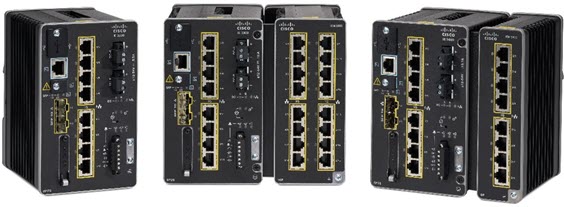If you’re going hiking, you need hiking boots—not dress shoes. In the same way, if you’re connecting assets in an industrial environment, you need an industrial ethernet switch, not an enterprise switch. In this first blog or our Industrial Ethernet Switching series, we will discuss what’s different about industrial ethernet switches.
Tight spaces: round pegs don’t fit in square holes
Industrial Ethernet switches bring high-speed connectivity outside traditional office buildings, factories, ports and terminals, railways, ships, energy farms, or mines. They connect industrial Internet of Things (IoT) devices like robots, cameras, wireless access points, sensors, and actuators. Anything with an ethernet port.
Some industrial environments have standard 19-inch racks, but many have cube-shaped metal enclosures shown below in Figure 1. To fit, industrial switches need to be cube-shaped. Introduced two decades ago, our industrial switches come in different sizes and support different numbers of connected devices—from 6 to 26 (figure 2).
 Figure 1 – Industrial Ethernet devices need to fit in cramped spaces
Figure 1 – Industrial Ethernet devices need to fit in cramped spaces

Figure 2 – Cisco IE3300 Rugged Series
Harsh environments: no A/C or other pampering
Enterprise switches operate in dry, temperature-controlled environments. In contrast, their industrial counterparts might be deployed in desert or arctic climates, dusty warehouses, wind farms, or vibrating places like trains. If you’re deploying at or near the sea, you might even need a waterproof switch. What’s more, the metal enclosures where switches are mounted typically have limited air flow and low power availability. That rules out fans, so our industrial switches are self-cooling, dissipating heat through the shell.
High reliability requirements: technicians might be hours away
Unlike office buildings, industrial spaces typically don’t have on-site IT staff. That means industrial switches need a long mean time between failures (MTBF). We build ours with industrial components and no moving parts.
The combination of high reliability and passive cooling add up to significant operational savings over the life span of an industrial ethernet switch.
Support for different industrial protocols: multi-lingual
When industrial ethernet switches hit the market, industrial end device vendors (for PLCs, sensors, cameras, etc.) started transitioning from proprietary fieldbus communications to ethernet communications. Based open standards protocol, ethernet eliminates vendor lock, reduces costs, and has the gigabit speeds to support all industrial automation protocols. Ethernet is one common communication infrastructure for all their industrial protocols.
Ethernet’s advantages caught on. Today, industrial ethernet end devices outnumber all other kinds combined as most innovations in industrial protocols rely on ethernet for communications. Helping the transition to ethernet, industrial ethernet switches support practically all industrial automation protocols, including Profinet, CIP/Ethernet IP, Powerlink, SERCOS III, CC-Link, MODBUS TCP, and others.
How are industrial switches changing it up?
Glad you asked! Put on your hiking boots and check back for our next blogs, where we’ll describe how industrial ethernet is transforming business, and the technology behind it.
Get more information on Cisco’s Industrial Ethernet portfolio, watch a short video on the latest Cisco Industrial Ethernet products, and find more Cisco IoT innovations here.
Subscribe to our newsletter to keep up with the latest Internet of Things trends and insights to help you succeed with your IoT deployments.

CONNECT WITH US